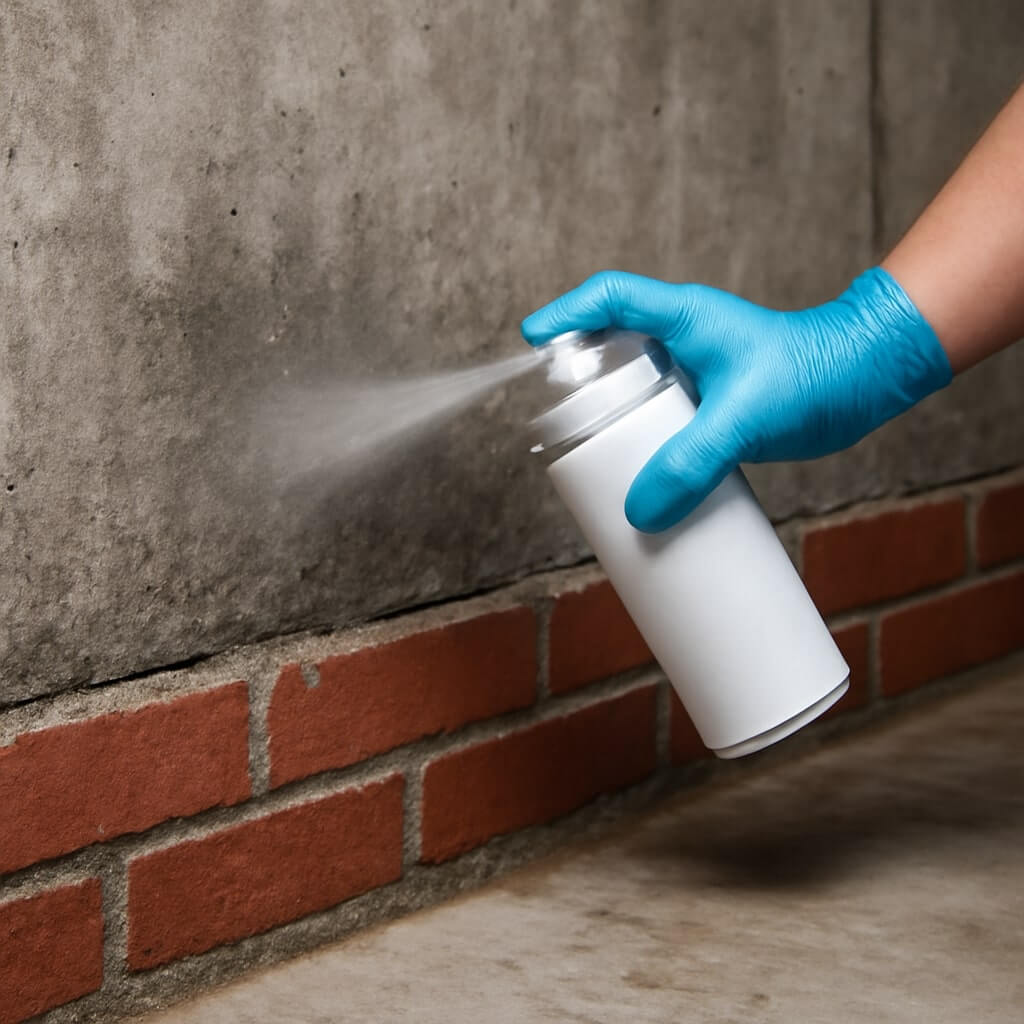When it comes to protecting your basement from water damage, choosing the right waterproofing spray is essential. You’ll want to take into account various factors, including the severity of moisture issues and the type of material you’re working with. From effective solutions for minor leaks to more robust options for serious problems, there are many products on the market. Understanding these differences will help you make an informed choice that suits your needs. Let’s explore your options.
Key Takeaways
- For minor leaks, consider brands like Drylok and Rust-Oleum, which use advanced polymers for effective sealing.
- Severe moisture issues may require liquid waterproofing membranes or specialized sealants for larger cracks.
- Eco-friendly options utilize natural ingredients and low-VOC formulations for sustainable moisture barriers.
- Evaluate cost-effectiveness by comparing silicone, acrylic, and polyurethane-based sprays within your budget.
- Customer feedback highlights durability, ease of application, and minimal odor as key features in top-rated products.
Understanding Basement Waterproofing Sprays
When it comes to protecting your home, understanding basement waterproofing sprays is vital. These products target basement humidity by creating a barrier that prevents water penetration.
Many homeowners fall for waterproofing myths, believing that all sprays are the same or that they can completely eliminate moisture. In reality, proper application and surface preparation are essential for effectiveness.
Look for sprays designed specifically for your basement’s material, whether it’s concrete, masonry, or wood. By debunking these myths and choosing the right product, you can greatly reduce moisture issues and protect your home from potential damage caused by dampness.
Key Features to Look for in Waterproofing Sprays
Selecting the right basement waterproofing spray hinges on understanding the key features that can enhance its performance. Focus on spray types, such as penetrating or topical, to match your needs. Consider the ease of use with application tools—some sprays require brushes, while others can be applied with a sprayer for quick coverage.
| Feature | Importance |
|---|---|
| Waterproofing Level | Determines effectiveness |
| Drying Time | Affects project timeline |
| Application Method | Influences ease of use |
| Compatibility | Guarantees adhesion to surfaces |
These features will guide you in making an informed choice.
Top Waterproofing Sprays for Minor Leaks
If you’re dealing with minor leaks in your basement, choosing the right waterproofing spray can make all the difference.
Look for products specifically designed for minor leak solutions, as these sprays often contain advanced polymers that bond to surfaces and seal small cracks effectively. Brands like Drylok and Rust-Oleum offer sprays that demonstrate impressive spray effectiveness, ensuring a durable barrier against moisture.
Before application, clean the area thoroughly to enhance adhesion.
Remember, while these sprays can manage minor leaks, regular inspection and maintenance are essential to prevent future issues.
Invest wisely, and you’ll protect your basement for years to come.
Best Options for Severe Moisture Problems
For homeowners facing severe moisture problems, relying solely on minor leak solutions won’t cut it.
You need effective strategies to guarantee severe leak prevention and a strong moisture barrier. Consider these options:
- Liquid Waterproofing Membrane: Forms a durable barrier against water intrusion.
- Sealant for Cracks: Specifically designed to fill and seal larger cracks effectively.
- Waterproofing Paint: Provides an extra layer of protection while enhancing aesthetics.
Implementing these products will help combat severe moisture issues and protect your basement from further damage.
Don’t wait – take action now to safeguard your home.
Eco-Friendly Waterproofing Spray Choices
When choosing eco-friendly waterproofing sprays, consider the benefits of natural ingredients, which can provide effective moisture barriers without harmful chemicals.
You’ll also want to familiarize yourself with various application techniques to guarantee peak performance.
Additionally, understanding the environmental impact of your choices can help you make a responsible selection that protects both your home and the planet.
Natural Ingredients Benefits
Although you might think waterproofing is all about chemical solutions, eco-friendly sprays with natural ingredients offer effective protection without harmful effects on your indoor air quality.
By choosing natural alternatives, you can guarantee safer ingredient sourcing, benefiting both your home and the environment.
Here are some advantages of using these sprays:
- Non-toxic: They reduce exposure to harmful chemicals.
- Sustainable: Many eco-friendly options utilize renewable resources.
- Mildew resistance: Natural ingredients often possess antifungal properties.
Embracing these benefits means you’re not only protecting your basement but also contributing to a healthier living space for you and your family.
Application Techniques Overview
To effectively apply eco-friendly waterproofing sprays, you need to follow specific techniques that guarantee maximum coverage and protection. Focus on proper spray application to enhance surface adhesion, ensuring a durable seal against moisture.
| Technique | Description |
|---|---|
| Surface Preparation | Clean and dry the area thoroughly. |
| Distance from Surface | Maintain 12-18 inches for even spray. |
| Overlapping Passes | Use 50% overlap for consistent coverage. |
| Multiple Coats | Apply at least two coats for best results. |
| Curing Time | Allow full drying before exposure to water. |
Using these techniques, you’ll achieve ideal waterproofing results with eco-friendly products.
Environmental Impact Considerations
As you consider waterproofing options for your basement, it’s crucial to evaluate the environmental impact of the products you choose.
Opting for eco-friendly waterproofing sprays can help you comply with environmental regulations while promoting product sustainability.
Here are some factors to keep in mind:
- Look for low-VOC (volatile organic compounds) formulations that minimize air pollution.
- Choose biodegradable options that break down naturally without harmful residues.
- Consider products with recycled materials in their packaging to reduce waste.
Application Techniques for Optimal Results
To achieve ideal results with basement waterproofing sprays, proper surface preparation is essential.
You should apply the spray evenly to guarantee full coverage, preventing any weak spots.
Additionally, pay attention to drying time, as this can considerably impact the effectiveness of the waterproofing solution.
Surface Preparation Importance
Proper surface preparation is essential for achieving effective basement waterproofing, and it can greatly impact the longevity of your project.
Before applying waterproofing sprays, make certain you’ve addressed these key steps:
- Surface Cleaning: Remove dirt, dust, and contaminants to promote adhesion.
- Substrate Preparation: Repair cracks and imperfections to create a smooth surface.
- Drying Time: Allow surfaces to dry completely before application to enhance effectiveness.
Even Application Techniques
Achieving an even application of basement waterproofing sprays is essential for guaranteeing maximum protection against moisture intrusion. To optimize results, you’ll want to use effective spray techniques. Start by holding the spray nozzle 12-18 inches from the surface and use steady, overlapping strokes. Here are some helpful application tips:
| Technique | Description | Benefits |
|---|---|---|
| Horizontal Spray | Move side to side | Reduces drips |
| Vertical Spray | Move top to bottom | Guarantees full coverage |
| Circular Motion | Use a circular pattern | Minimizes missed spots |
Following these tips will enhance your waterproofing efforts.
Drying Time Considerations
While you focus on applying basement waterproofing sprays, understanding drying time considerations is essential for ideal results. Several drying factors and humidity effects can greatly influence the performance of the spray.
To optimize the drying process, consider these points:
- Temperature: Warmer conditions can accelerate drying times, while colder environments may prolong them.
- Airflow: Improved ventilation aids in quicker evaporation of moisture from the spray.
- Humidity Levels: High humidity can slow down drying, leading to potential issues with adherence and effectiveness.
Comparing Costs and Effectiveness
When evaluating basement waterproofing sprays, you need to contemplate both costs and effectiveness to make an informed decision. A cost comparison helps you assess your budget, while an effectiveness evaluation guarantees long-term protection. Below is a simple table to assist in your decision-making:
| Spray Type | Average Cost |
|---|---|
| Silicone-based | $20-$50 |
| Acrylic-based | $15-$40 |
| Polyurethane-based | $30-$80 |
Customer Reviews and Recommendations
Customer feedback can greatly influence your decision on the best basement waterproofing spray.
Reading reviews helps you gauge customer satisfaction and product effectiveness.
Here are key points to reflect on:
- Durability: Many users report lasting results, emphasizing the importance of long-term protection.
- Ease of Application: Customers appreciate products that are easy to apply, saving time and reducing hassle.
- Odor and Cleanup: Positive reviews often highlight minimal odor and straightforward cleanup processes.
Conclusion
In summary, selecting the right basement waterproofing spray is essential for protecting your home from moisture damage. Whether you’re tackling minor leaks or severe issues, there are effective options available to meet your needs. Don’t overlook eco-friendly choices, which provide non-toxic solutions. Remember to apply the product correctly for the best results. By considering customer reviews and evaluating the cost-effectiveness of different sprays, you can make an informed decision that guarantees long-lasting protection for your basement.

